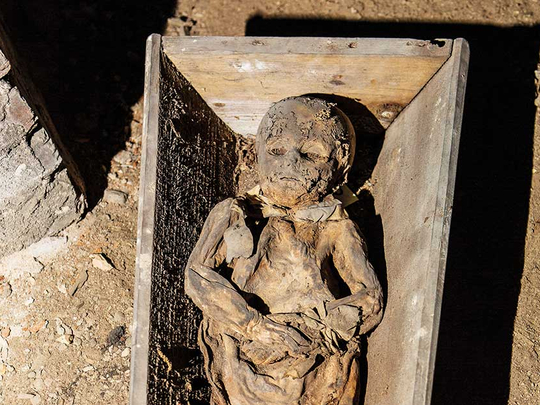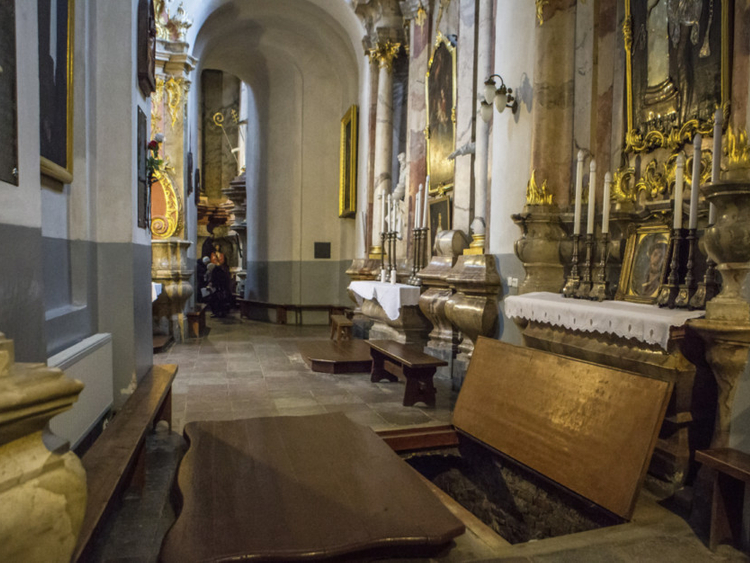
Hundreds of skeletons have lain scattered around a crypt beneath a church in Vilnius, Lithuania, for centuries. But 23 of these remains are unlike the rest: Flesh wraps their bones, clothes cover their skin, and organs still fill their insides.
They are mummies, and since they were recovered about five years ago, scientists have investigated their secrets, seeking insights into the lives of people in the 17th, 18th and 19th centuries and the diseases they suffered.
“They are so well preserved that they almost look alive,” said Dario Piombino-Mascali, an anthropologist from Italy who has studied the mummies since 2011.
Recently, Piombino-Mascali and his colleagues have uncovered remnants of the smallpox virus in one of the mummies, gaining new insights into the origins of a deadly scourge that killed an estimated 300 million people in the 20th century alone.
The work follows on their earlier discoveries: signs of rickets, osteoarthritis and intestinal parasites in the mummies. And they are not the only researchers unearthing new findings from the bodies of the long dead but well preserved.
The study of mummified remains in other parts of the world has yielded historical perspective on the spread of deadly diseases and damaging medical conditions, from heart disease in pre-Columbian Americans to various strains of tuberculosis in 19th-century Europeans.
By understanding how long these diseases have been around and mapping them historically, scientists can better tackle them today.
“Most people don’t realise you can learn about modern medicine from ancient mummies,” said Frank Ruehli, head of the Swiss Mummy Project at the University of Zurich in Switzerland, who is studying the internal organs of Iranian and Egyptian mummies.
“These historic patient records are like a box of candy for us.”
A crypt in the heart of a capital
In the heart of Vilnius, Lithuania’s Dominican Church of the Holy Spirit is a bright masterpiece of Late Baroque architecture. But it hides something darker.
Inside, an altar stands behind a large wooden platform where people kneel and pray. Beneath this is a stone staircase so narrow it can admit only one person at a time. Researchers liken it to an entrance to a secret lair: The steps descend to a dark and dusty underworld.
A black metal gate leads to the labyrinthine chambers that house the corpses. Once, there were body parts piled into a pyramid on the floor and stacked on shelves that reached to the ceiling.
For most of their history, the corpses were preserved intact: Cool temperatures and ventilation in the underground chamber had caused them to undergo spontaneous mummification. Though they faced disturbances over the centuries as the city and church were occupied by Napoleon, then the Nazis, it was the Soviet occupation of Lithuania that brought about a drastic change in the mummies’ fate.
In the 1960s, a forensic scientist named Juozas Albinas Markulis became one of the first to study the mummies. He wanted to know whether there were victims from the Second World War mixed in among the 17th-, 18th- and 19th-century corpses. (Oddly, Markulis is better known to Lithuanians not as a scientist but as a former spy who, while posing as a leader of the Lithuanian resistance, lured others into Soviet ambushes.)
Markulis and his students at Vilnius University identified 500 bodies in the crypt, of which about 200 had been mummified. In 1962, government officials inspected the crypt and ordered that the mummies be sealed behind glass, fearful that infected bodies might start an epidemic. They called it the Chamber of Death.
Soon a glass wall was erected, but it stopped the airflow and made the environment too humid and caused the mummies to decay. Markulis tried to save them, but his pleas were ignored by the Lithuanian government. The site was soon closed and remained unstudied until anthropologists returned to the chamber in 2004.
From 2008 to 2011, researchers began inspecting and extracting the mummies from the crypt. Of the 200 studied by Markulis, who died in 1987, only 23 remained intact.
But while Markulis sought to uncover the identities of the mummies, Piombino-Mascali and his colleagues focused on how they lived.
Mummified medical mysteries
Looking at the remains, Piombino-Mascali identified several with dental decay and gum disease, as well as arthritis and bone deformities. To further investigate their health issues, he performed CT scans on the seven best-preserved mummies.
One obese man once had arthritis in his spine, pelvis and both knees, a fractured rib on his right side and an enlarged thyroid gland, which might have been caused by goiter. An obese woman had a benign tumour in her lower back. Both had suffered from clogged arteries, a health problem usually associated with modern diets.
“It was very strange,” Piombino-Mascali said of the examinations, “because we were not feeling as if they were just objects of cultural and archaeological interest. It was a feeling like they were with us willing to do a checkup for their medical conditions.”
The researchers sent samples from a 17th century mummified child to a colleague in Canada, who uncovered remnants of variola virus that causes smallpox, which once ravaged most of the world. By sequencing the virus, the team has gained insight into the origins of the deadly scourge.
“There was no evidence on any remains that would suggest a smallpox infection, so the presence of variola virus was very surprising,” said Ana Duggan, a biologist from McMaster University who worked with Piombino-Mascali. “It’s the oldest complete genome that we have of variola virus.”
She said the ancient DNA has helped them map out the timeline of smallpox. Historical accounts from Eygpt, China and India had suggested that smallpox had infected humans for thousands of years. But by comparing the 17th century strain with modern variola samples, they found the strains shared a common ancestor that emerged between 1530 and 1654. Their finding suggests that the deadliest kinds of smallpox may have evolved much more recently than previously thought.
Contemporary health and ancient remains
The discovery in the Lithuanian crypt is one of the latest in a long line of important medical findings that have used intensive analysis of mummified to show how diseases connect modern humans to the experiences of our forebears.
In 2013, a team led by Dr. Randall C. Thompson, a cardiologist at St. Luke’s Mid America Heart Institute in Kansas City, Missouri, performed CT scans on 130 mummies from ancient Egypt and pre-Columbian Peru, as well as those of Native Americans in the Southwest and the Unangan people of the Aleutian Islands.
He and his colleagues discovered that more than a third of the mummies had some form of atherosclerosis, or hardening of the arteries, which can lead to heart disease. The affected mummies came from various geographical regions and lived over a span of more than 4,000 years - a reminder that heart troubles have long been prevalent and are not simply the result of modern diets.
“We found that heart disease is older than Moses,” he said. “This disease was present and not hard to find all over the world covering a wide swath of human history.”
Using burial markings on the tombs, they identified their oldest case of coronary heart disease in Ahmose-Meritamun, an Egyptian princess who lived from 1550 to 1580 B.C. and was in her 40s when she died. The oldest example of clogged arteries they found belonged to an Egyptian mummy from around 2,000 B.C.
Mark Pallen, a professor of microbial genomics at the University of Warwick, made similar findings in 2015 while studying tuberculosis in mummies found in a Hungarian crypt with more than 200 bodies.
He and his team had extracted tuberculosis bacteria DNA from the lungs of eight 200-year-old mummies, discovering that ancient people could get multiple strains of the bacteria throughout their lifetimes.
They used a technique known as metagenomics sequencing, which had not been previously used on mummified corpses. It allowed the researchers to extract microbial DNA directly rather than having to grow the bacteria on a plate.
Because of its success in mummies, he had used the technique with mucus samples from people to get DNA from tuberculosis bacteria. “In this case, the dead did instruct the living,” Pallen said.
Back in Lithuania, Piombino-Mascali said cases of both atherosclerosis and tuberculosis had been found among mummies in the church crypt. The findings offered evidence that even the upper class in 18th- and 19th-century Vilnius experienced chronic health problems, including those related to poor nutrition.
But most important to Piombino-Mascali, the mummies now are sharing their stories.
“That crypt was a witness to all of the historical faces of Vilnius,” Piombino-Mascali said. “But now it’s finally given back to the city. The stories belong to Lithuania and especially the Lithuanian people.”
–New York Times News Service














